engine Alfa Romeo 159 2008 Owner handbook (in English)
[x] Cancel search | Manufacturer: ALFA ROMEO, Model Year: 2008, Model line: 159, Model: Alfa Romeo 159 2008Pages: 303, PDF Size: 5.18 MB
Page 155 of 303
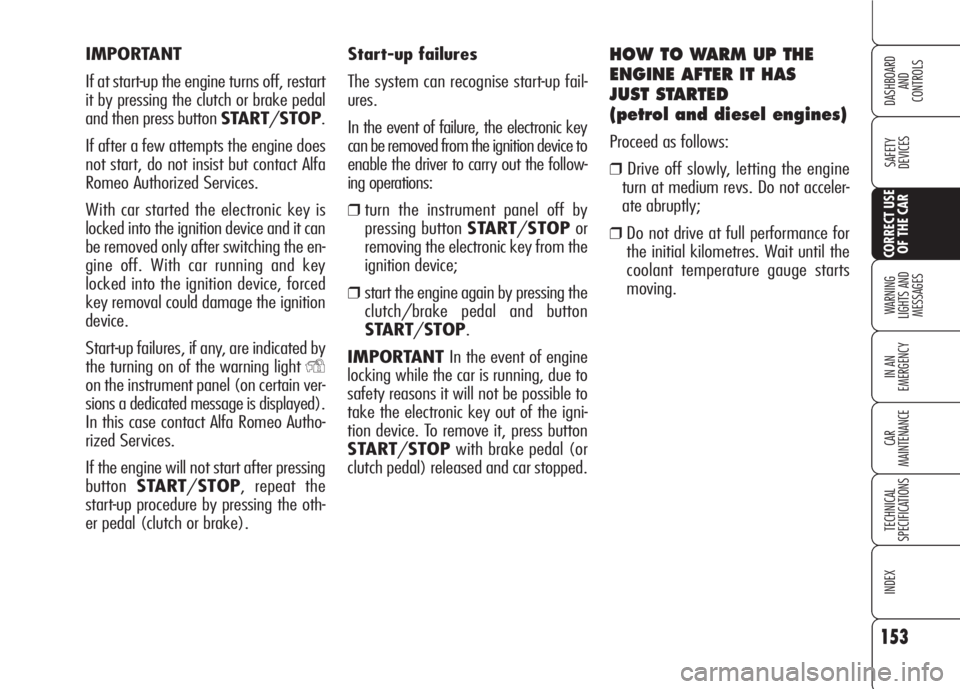
153
SAFETY
DEVICES
WARNING
LIGHTS AND
MESSAGES
IN AN
EMERGENCY
CAR
MAINTENANCE
TECHNICAL
SPECIFICATIONS
INDEX
DASHBOARD
AND
CONTROLS
CORRECT USE
OF THE CAR
IMPORTANT
If at start-up the engine turns off, restart
it by pressing the clutch or brake pedal
and then press button START/STOP.
If after a few attempts the engine does
not start, do not insist but contact Alfa
Romeo Authorized Services.
With car started the electronic key is
locked into the ignition device and it can
be removed only after switching the en-
gine off. With car running and key
locked into the ignition device, forced
key removal could damage the ignition
device.
Start-up failures, if any, are indicated by
the turning on of the warning light
Y
on the instrument panel (on certain ver-
sions a dedicated message is displayed).
In this case contact Alfa Romeo Autho-
rized Services.
If the engine will not start after pressing
buttonSTART/STOP, repeat the
start-up procedure by pressing the oth-
er pedal (clutch or brake). Start-up failures
The system can recognise start-up fail-
ures.
In the event of failure, the electronic key
can be removed from the ignition device to
enable the driver to carry out the follow-
ing operations:
❒turn the instrument panel off by
pressing button START/STOPor
removing the electronic key from the
ignition device;
❒start the engine again by pressing the
clutch/brake pedal and button
START/STOP.
IMPORTANT In the event of engine
locking while the car is running, due to
safety reasons it will not be possible to
take the electronic key out of the igni-
tion device. To remove it, press button
START/STOPwith brake pedal (or
clutch pedal) released and car stopped.
HOW TO WARM UP THE
ENGINE AFTER IT HAS
JUST STARTED
(petrol and diesel engines)
Proceed as follows:
❒Drive off slowly, letting the engine
turn at medium revs. Do not acceler-
ate abruptly;
❒Do not drive at full performance for
the initial kilometres. Wait until the
coolant temperature gauge starts
moving.
Page 156 of 303

154
SAFETY
DEVICES
WARNING
LIGHTS AND
MESSAGES
IN AN
EMERGENCY
CAR
MAINTENANCE
TECHNICAL
SPECIFICATIONS
INDEX
DASHBOARD
AND
CONTROLS
CORRECT USE
OF THE CAR
IMPORTANTAfter a taxing drive, you
should allow the engine to “catch its
breath” before turning it off by letting it
idle to allow the temperature in the en-
gine compartment to fall.
IMPORTANTTurning the car off will
deactivate the electronic safety systems
and turn off the external lights.IMPORTANTIn the event of engine
locking while the car is running, due to
safety reasons it will not be possible to
take the electronic key out of the igni-
tion device. To remove it, turn the in-
strument panel on and off by pressing
buttonSTART/STOPwith brake ped-
al (and clutch pedal) released and car
stopped.
REMOVING THE ELECTRONIC
KEY FROM THE IGNITION
DEVICE IN AN EMERGENCY
In the event of a failure at engine switch-
ing off system or at electronic key un-
locking system proceed as follows:
❒press the unlocking button to remove
the metal insert (see paragraph
“Electronic key” in section “Dash-
board and controls”);
STOPPING THE ENGINE
With car stopped press button START/
STOP. When the engine is off it will be
possible to remove the electronic key
from the ignition device.
A quick burst on the ac-
celerator before turning
off the engine serves
absolutely no practical purpose,
it wastes fuel and is damaging
especially to turbocharged en-
gines.❒fit the metal insert B-fig. 1of the
electronic key into the slot A;
❒remove the electronic key from the
ignition device.
IMPORTANTOnly fit the metal insert
Bof the electronic key into slot A-fig.1.
IMPORTANTStop the car before
emergency removal of the key, since re-
moving the key with the engine running
will turn both the engine and the in-
strument panel off and the steering lock
will not be engaged.
A0E0043mfig. 1In an emergency, and
for safety reasons the
engine can be turned off when
the car is running by pressing
repeatedly (3 times within
2 seconds) or by keeping
pressed button START/STOP
for a few seconds. In this case
the steering lock cannot be en-
gaged.
WARNING
Page 157 of 303
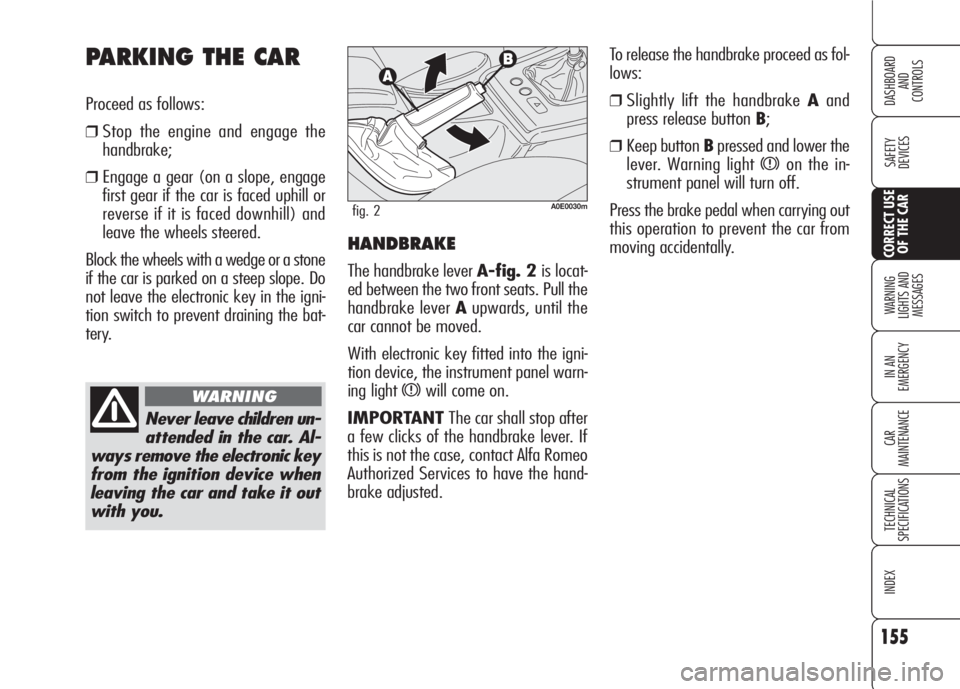
155
SAFETY
DEVICES
WARNING
LIGHTS AND
MESSAGES
IN AN
EMERGENCY
CAR
MAINTENANCE
TECHNICAL
SPECIFICATIONS
INDEX
DASHBOARD
AND
CONTROLS
CORRECT USE
OF THE CAR
To release the handbrake proceed as fol-
lows:
❒Slightly lift the handbrake Aand
press release button B;
❒Keep button Bpressed and lower the
lever. Warning light
xon the in-
strument panel will turn off.
Press the brake pedal when carrying out
this operation to prevent the car from
moving accidentally.
HANDBRAKE
The handbrake lever A-fig. 2 is locat-
ed between the two front seats. Pull the
handbrake lever Aupwards, until the
car cannot be moved.
With electronic key fitted into the igni-
tion device, the instrument panel warn-
ing light
xwill come on.
IMPORTANT The car shall stop after
a few clicks of the handbrake lever. If
this is not the case, contact Alfa Romeo
Authorized Services to have the hand-
brake adjusted.
A0E0030mfig. 2
PARKING THE CAR
Proceed as follows:
❒Stop the engine and engage the
handbrake;
❒Engage a gear (on a slope, engage
first gear if the car is faced uphill or
reverse if it is faced downhill) and
leave the wheels steered.
Block the wheels with a wedge or a stone
if the car is parked on a steep slope. Do
not leave the electronic key in the igni-
tion switch to prevent draining the bat-
tery.
Never leave children un-
attended in the car. Al-
ways remove the electronic key
from the ignition device when
leaving the car and take it out
with you.
WARNING
Page 158 of 303

156
SAFETY
DEVICES
WARNING
LIGHTS AND
MESSAGES
IN AN
EMERGENCY
CAR
MAINTENANCE
TECHNICAL
SPECIFICATIONS
INDEX
DASHBOARD
AND
CONTROLS
CORRECT USE
OF THE CAR
IMPORTANT The car can only be put
into reverse gear when it has stopped
moving completely. With the engine run-
ning, before engaging the reverse, wait
at least 3 seconds with the clutch ped-
al fully down to prevent damage and
grating of the gears.
A0E0151mfig. 4
To change gears prop-
erly you must push the
clutch pedal fully down. It is
therefore essential that there
is nothing under the pedals:
make sure mats are lying flat
and do not get in the way of
the pedals.
WARNING
Do not drive with your
hand resting on the gear
lever as the force ex-
erted, even if slight, could lead
over time to premature wear on
the gearbox internal compo-
nents.
USING THE
GEARBOX
The car can be fitted with 6-gear or
5-gear manual gearbox (1.8 version).
Gear positions are shown on the
gearshift lever knob.
Always press down the clutch pedal
when shifting gears. To engage the 6
th
gear, move the gearshift lever pressing
slightly rightwards to prevent engaging
the 4
thgear accidentally.
To engage reverse Rfrom neutral, raise
ringA-fig. 3orA-fig. 4 under the
knob and at the same time move the
gearshift lever leftwards and then for-
ward. After engaging reverse release the
ring. To shift from reverse to another
gear it is not necessary to raise the ring.
A0E0397mfig. 3
Page 159 of 303
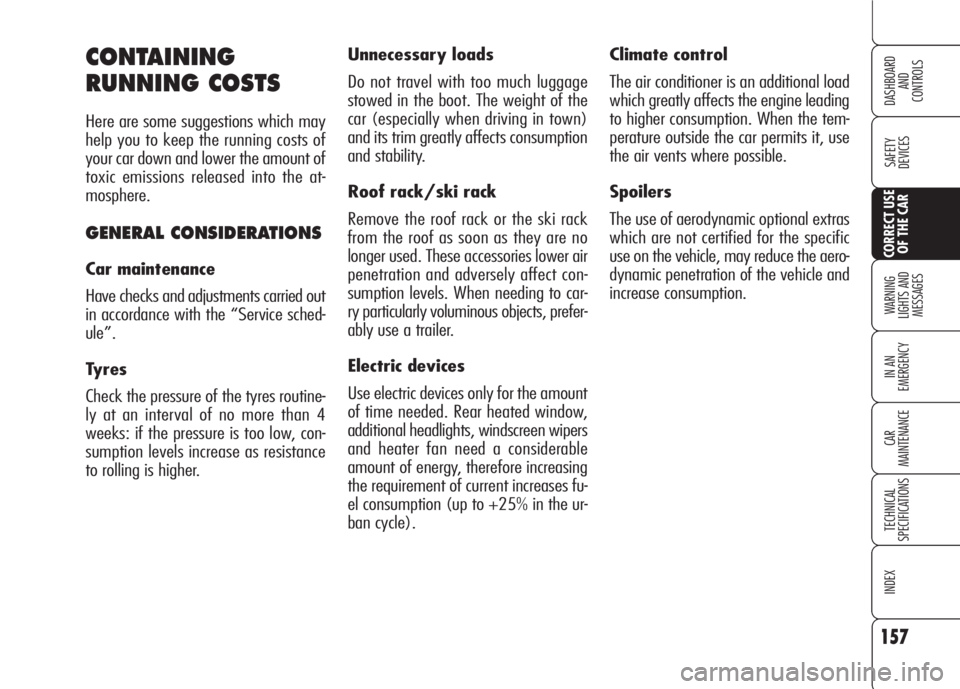
157
SAFETY
DEVICES
WARNING
LIGHTS AND
MESSAGES
IN AN
EMERGENCY
CAR
MAINTENANCE
TECHNICAL
SPECIFICATIONS
INDEX
DASHBOARD
AND
CONTROLS
CORRECT USE
OF THE CAR
Climate control
The air conditioner is an additional load
which greatly affects the engine leading
to higher consumption. When the tem-
perature outside the car permits it, use
the air vents where possible.
Spoilers
The use of aerodynamic optional extras
which are not certified for the specific
use on the vehicle, may reduce the aero-
dynamic penetration of the vehicle and
increase consumption. Unnecessary loads
Do not travel with too much luggage
stowed in the boot. The weight of the
car (especially when driving in town)
and its trim greatly affects consumption
and stability.
Roof rack/ski rack
Remove the roof rack or the ski rack
from the roof as soon as they are no
longer used. These accessories lower air
penetration and adversely affect con-
sumption levels. When needing to car-
ry particularly voluminous objects, prefer-
ably use a trailer.
Electric devices
Use electric devices only for the amount
of time needed. Rear heated window,
additional headlights, windscreen wipers
and heater fan need a considerable
amount of energy, therefore increasing
the requirement of current increases fu-
el consumption (up to +25% in the ur-
ban cycle).CONTAINING
RUNNING COSTS
Here are some suggestions which may
help you to keep the running costs of
your car down and lower the amount of
toxic emissions released into the at-
mosphere.
GENERAL CONSIDERATIONS
Car maintenance
Have checks and adjustments carried out
in accordance with the “Service sched-
ule”.
Tyres
Check the pressure of the tyres routine-
ly at an interval of no more than 4
weeks: if the pressure is too low, con-
sumption levels increase as resistance
to rolling is higher.
Page 160 of 303

158
SAFETY
DEVICES
WARNING
LIGHTS AND
MESSAGES
IN AN
EMERGENCY
CAR
MAINTENANCE
TECHNICAL
SPECIFICATIONS
INDEX
DASHBOARD
AND
CONTROLS
CORRECT USE
OF THE CAR
Gear selection
As soon as the conditions of the traffic
and road allow, use a higher gear. Us-
ing a low gear to obtain brilliant perfor-
mance increases consumption. In the
same way improper use of a high gear
increases consumption, emissions an en-
gine wear.
Top speed
Fuel consumption considerably increas-
es with speed. Avoid superfluous brak-
ing and accelerating, which cost in terms
of both fuel and emissions.
Acceleration
Accelerating violently increasing the revs
will greatly affect consumption and emis-
sions: acceleration should be gradual and
should not exceed the maximum torque.CONDITIONS OF USE
Cold starting
Short journeys and frequent cold starts
do not allow the engine to reach opti-
mum operating temperature. This results
in a significant increase in consumption
levels (from +15 to +30% on the urban
cycle) and emission of harmful sub-
stances.
Traffic and road conditions
Rather high consumption levels are tied
to situations with heavy traffic, for ex-
ample in queues with frequent use of
the lower gears or in cities with many
traffic lights. Also winding mountain
roads and rough road surfaces adverse-
ly affect consumption.
Traffic hold-ups
During prolonged hold-ups (e.g.: level
crossings) the engine should be
switched off.
DRIVING STYLE
Starting
Do not warm the engine with the car
at a standstill or at idle or high speed:
under these conditions the engine
warms up much more slowly, increasing
electrical consumption and emissions. It
is therefore advisable to move off im-
mediately, slowly, avoiding high speeds.
This way the engine will warm faster.
Unnecessary actions
Avoid accelerating when waiting at traf-
fic lights or before switching off the en-
gine. This and also double declutching
is absolutely pointless on modern cars
and also increase consumption and pol-
lution.
Page 166 of 303

164
SAFETY
DEVICES
WARNING
LIGHTS AND
MESSAGES
IN AN
EMERGENCY
CAR
MAINTENANCE
TECHNICAL
SPECIFICATIONS
INDEX
DASHBOARD
AND
CONTROLS
CORRECT USE
OF THE CAR
CAR INACTIVITY
If the car is to be left inactive for longer
than a month, the following precautions
should be noted:
❒ park the car in covered, dry and if
possible well-ventilated premises;
❒ engage a gear;
❒check that the handbrake is not en-
gaged;
❒disconnect battery negative terminal
and check the battery charge. This
check is to be repeated every three
months when the car is left inactive.
Recharge if the optical(where pro-
vided) indicator shows a dark colour
without the central green area (see
paragraph “Battery” in “Car main-
tenance” section);
❒clean and protect the painted parts
using protective wax;
❒clean and protect the shiny metal
parts using special compounds read-
ily available;
❒sprinkle talcum powder on the rubber
windscreen and rear window wiper
blades and lift them off the glass;
❒slightly open the windows;
❒cover the car with a cloth or perfo-
rated plastic sheet. Do not use sheets
of non-perforated plastic as they do
not allow moisture on the car body
to evaporate;
❒inflate tyres to +0.5 bar above the
normal specified pressure and check
it at intervals;
❒if you don’t disconnect the battery
from the electric system, check its
charge every month and recharge it
if the optical indicator shows a dark
colour without the central green area;
❒ do not drain the engine cooling sys-
tem.
IMPORTANTIf the car is fitted with
alarm system, switch off the alarm with
the remote control.
Page 167 of 303

165
SAFETY
DEVICES
IN AN
EMERGENCY
CAR
MAINTENANCE
TECHNICAL
SPECIFICATIONS
INDEX
CORRECT USE
OF THE CAR
DASHBOARD
AND
CONTROLS
WARNING
LIGHTS AND
MESSAGES
W W
A A
R R
N N
I I
N N
G G
L L
I I
G G
H H
T T
S S
A A
N N
D D
M M
E E
S S
S S
A A
G G
E E
S S
LOW BRAKE FLUID/HANDBRAKE ON ..................... 167
BRAKE PAD WEAR ............................................. 167
SEAT BELTS NOT FASTENED ................................. 167
AIR BAG FAILURE................................................ 168
PASSANGER’S FRONT AIR BAGS DEACTIVATED ........ 169
ENGINE COOLANT HIGH TEMPERATURE.................. 169
ENGINE OIL HIGH TEMPERATURE .......................... 170
LOW ENGINE OIL PRESSURE/
EXHAUST OIL..................................................... 170
LOW BATTERY CHARGE ....................................... 170
INCOMPLETE DOOR LOCKING ............................... 171
BONNET OPEN ................................................... 171
BOOT OPEN....................................................... 171
INJECTION SYSTEM FAILURE/
EOBD SYSTEM FAILURE....................................... 171
CAR PROTECTION SYSTEM FAILURE/
STEERING LOCK INHIBITION................................. 172
ALARM FAILURE/BREAK-IN ATTEMPT
ELECTRONIC KEY NOT RECOGNIZED ...................... 172
POSSIBLE PRESENCE OF ICE ON THE ROAD............ 173
PRE-HEATING GLOW PLUGS/
PRE-HEATING GLOW PLUG FAILURE ....................... 173
WATER IN DIESEL FUEL FILTER ............................. 174
INERTIAL FUEL CUT-OFF SWITCHED ON ................. 174
ABS SYSTEM FAILURE......................................... 175
EBD SYSTEM FAILURE......................................... 175VDC SYSTEM .................................................... 175
HILL HOLDER FAILURE ........................................ 176
ASR SYSTEM (WHEEL ANTISKID SYSTEM) ............. 176
EXTERNAL LIGHTS FAILURE .................................. 176
BRAKE LIGHTS FAILURE ....................................... 177
REAR FOGLIGHTS ............................................... 177
FRONT FOG LIGHTS ............................................ 177
SIDE/TAILLIGHTS/FOLLOW ME HOME .................. 177
DIPPED BEAM HEADLIGHTS.................................. 177
MAIN BEAM HEADLIGHTS .................................... 177
LEFT-HAND DIRECTION INDICATOR ........................ 177
RIGHT-HAND DIRECTION INDICATOR ...................... 177
LIGHT SENSOR FAILURE........................................ 178
RAIN SENSOR FAILURE......................................... 178
PARKING SENSORS FAILURE ................................ 178
FUEL RESERVE – LIMITED CRUISING RANGE .......... 178
CRUISE CONTROL .............................................. 178
DIESEL PARTICULATE FILTER CLOGGED .................. 178
ANTIPINCH SYSTEM FAILURE ............................... 179
WINDSCREEN WASHER FLUID LOW LEVEL ............. 179
SPEED LIMIT EXCEEDED ..................................... 179
T.P.M.S. SYSTEM FAILURE ................................... 179
CHECK TYRE PRESSURE ...................................... 179
LOW INFLATION PRESSURE ................................. 180
TYRE PRESSURE UNSUITABLE FOR SPEED ............. 180
Page 171 of 303
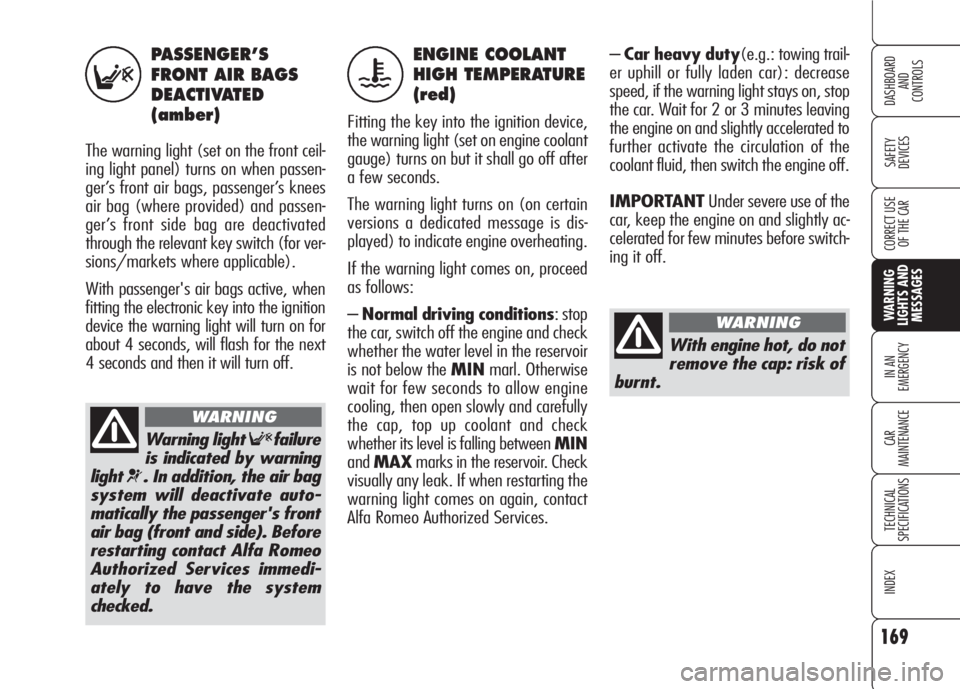
169
SAFETY
DEVICES
IN AN
EMERGENCY
CAR
MAINTENANCE
TECHNICAL
SPECIFICATIONS
INDEX
CORRECT USE
OF THE CAR
DASHBOARD
AND
CONTROLS
WARNING
LIGHTS AND
MESSAGES
PASSENGER’S
FRONT AIR BAGS
DEACTIVATED
(amber)
The warning light (set on the front ceil-
ing light panel) turns on when passen-
ger’s front air bags, passenger’s knees
air bag (where provided) and passen-
ger’s front side bag are deactivated
through the relevant key switch (for ver-
sions/markets where applicable).
With passenger's air bags active, when
fitting the electronic key into the ignition
device the warning light will turn on for
about 4 seconds, will flash for the next
4 seconds and then it will turn off.
F
–Car heavy duty(e.g.: towing trail-
er uphill or fully laden car): decrease
speed, if the warning light stays on, stop
the car. Wait for 2 or 3 minutes leaving
the engine on and slightly accelerated to
further activate the circulation of the
coolant fluid, then switch the engine off.
IMPORTANTUnder severe use of the
car, keep the engine on and slightly ac-
celerated for few minutes before switch-
ing it off.
Warning light Ffailure
is indicated by warning
light
¬. In addition, the air bag
system will deactivate auto-
matically the passenger's front
air bag (front and side). Before
restarting contact Alfa Romeo
Authorized Services immedi-
ately to have the system
checked.
WARNING
ENGINE COOLANT
HIGH TEMPERATURE
(red)
Fitting the key into the ignition device,
the warning light (set on engine coolant
gauge) turns on but it shall go off after
a few seconds.
The warning light turns on (on certain
versions a dedicated message is dis-
played) to indicate engine overheating.
If the warning light comes on, proceed
as follows:
–Normal driving conditions: stop
the car, switch off the engine and check
whether the water level in the reservoir
is not below the MINmarl. Otherwise
wait for few seconds to allow engine
cooling, then open slowly and carefully
the cap, top up coolant and check
whether its level is falling between MIN
andMAXmarks in the reservoir. Check
visually any leak. If when restarting the
warning light comes on again, contact
Alfa Romeo Authorized Services.
u
With engine hot, do not
remove the cap: risk of
burnt.
WARNING
Page 172 of 303
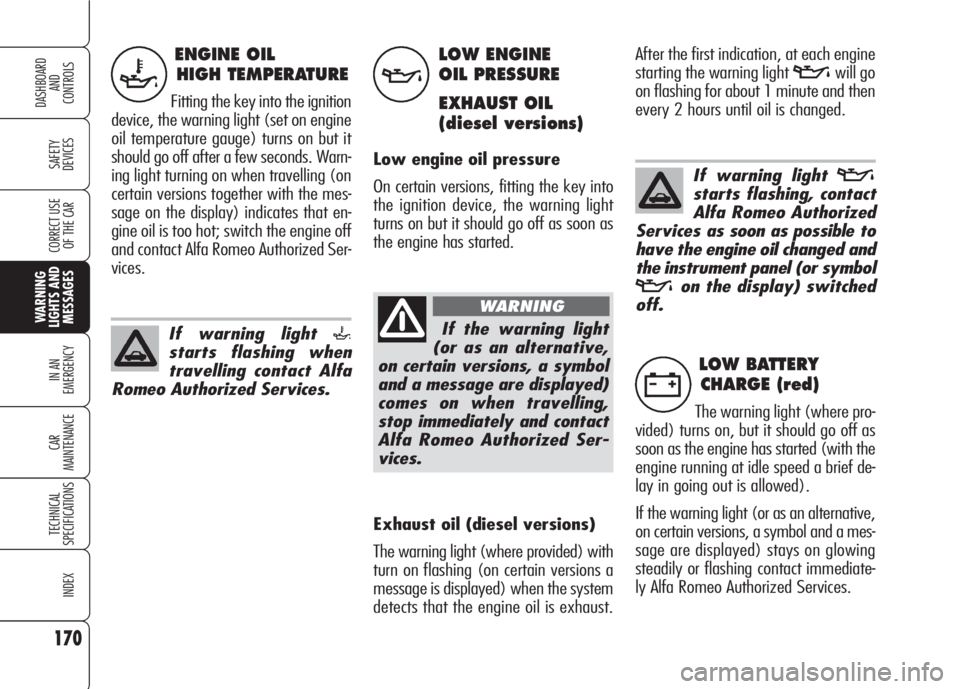
170
SAFETY
DEVICES
IN AN
EMERGENCY
CAR
MAINTENANCE
TECHNICAL
SPECIFICATIONS
INDEX
CORRECT USE
OF THE CAR
DASHBOARD
AND
CONTROLS
WARNING
LIGHTS AND
MESSAGES
ENGINE OIL
HIGH TEMPERATURE
Fitting the key into the ignition
device, the warning light (set on engine
oil temperature gauge) turns on but it
should go off after a few seconds. Warn-
ing light turning on when travelling (on
certain versions together with the mes-
sage on the display) indicates that en-
gine oil is too hot; switch the engine off
and contact Alfa Romeo Authorized Ser-
vices.
If warning light
`
starts flashing when
travelling contact Alfa
Romeo Authorized Services.
LOW ENGINE
OIL PRESSURE
EXHAUST OIL
(diesel versions)
Low engine oil pressure
On certain versions, fitting the key into
the ignition device, the warning light
turns on but it should go off as soon as
the engine has started.After the first indication, at each engine
starting the warning light
vwill go
on flashing for about 1 minute and then
every 2 hours until oil is changed.
LOW BATTERY
CHARGE (red)
The warning light (where pro-
vided) turns on, but it should go off as
soon as the engine has started (with the
engine running at idle speed a brief de-
lay in going out is allowed).
If the warning light (or as an alternative,
on certain versions, a symbol and a mes-
sage are displayed) stays on glowing
steadily or flashing contact immediate-
ly Alfa Romeo Authorized Services.
w
`v
If the warning light
(or as an alternative,
on certain versions, a symbol
and a message are displayed)
comes on when travelling,
stop immediately and contact
Alfa Romeo Authorized Ser-
vices.
WARNING
If warning light v
starts flashing, contact
Alfa Romeo Authorized
Services as soon as possible to
have the engine oil changed and
the instrument panel (or symbol
von the display) switched
off.
Exhaust oil (diesel versions)
The warning light (where provided) with
turn on flashing (on certain versions a
message is displayed) when the system
detects that the engine oil is exhaust.